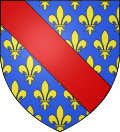Allier
Allier (UK: /ˈælieɪ/ AL-ee-ay,[3] US: /ælˈjeɪ, ɑːlˈjeɪ/ a(h)l-YAY,[4][5] French: [alje] ⓘ; Occitan: Alèir) is a department in the Auvergne-Rhône-Alpes region that borders Cher to the west, Nièvre to the north, Saône-et-Loire and Loire to the east, Puy-de-Dôme to the south, and Creuse to the south-west.Commonly grouped under the name of Val d'Allier, the Limagne and Forterre extend on both sides of the river between Vichy and Saint-Pourçain-sur-Sioule with an essential quality of fertility.Limogne, together with Sioule and Allier, is part of the Gannat / Escurolles / Saint-Pourçain triangle while Forterre covers the Canton of Varennes-sur-Allier ending near Jaligny.The department is wide open to Atlantic influences and enjoys a mild and humid climate dominated by westerly winds which helps a little to differentiate it from other parts of Auvergne.The weather variances coincide with the diversity of Bourbonnais territory such as: flat regions, low altitude Bourbonnais Sologne and large floodplains, the hill country, the average altitude of 300 to 600 metres, the central part of the department, and the semi-mountainous southern townships bordering the Combraille and Forez between 700 and 1,200 metres.Until the end of the 19th century, however, the population was increasing because the development of its cities (industries at Montluçon and Moulins, spas in Vichy) compensated by the rural exodus.Since then, the continuing rural exodus and especially the decline of old industries has made the population decrease and age steadily, from 386,533 inhabitants in 1968 to 337,988 in 2017.From 2008 the left coalition was in control also with a majority of one vote (10 PC, 6 PS, 2 PRG, 18 seats in total), facing 17 councilors from the URB.[28] Adverse conditions made sharecroppers promote the creation of rural unions between 1904 and 1911 (the third greatest number per department in France after Hérault and Landes).Landscapes such as Bourbonnais bocage, the gorges of the Sioule, and the Forest of Tronçais are places suitable for the practice of outdoor activities: hiking, fishing, and white water sports.This nature preserve also features over 500 castles, Romanesque churches and a number of houses which represent the heritage of the Bourbons.[citation needed] Bourbon cuisine reflects the history of the province and provides a number of local products, including Pâté aux pommes de terre, Charolais beef, wines from Saint-Pourçain AOC, Charroux mustard, and Vichy pastilles.[citation needed] Among the tourist sites to visit are: The pâté aux pommes de terre is one of the specialities of the Allier, as well as of the neighboring Limousin region.
Allier (disambiguation)OccitanDepartmentPrefectureMoulinsCountryFranceRegionAuvergne-Rhône-AlpesSubprefecturesMontluçonPresident of the Departmental CouncilTime zoneDepartment numberArrondissementsCantonsCommunesestuariesNièvreSaône-et-LoirePuy-de-DômeCreuseAllierpost codeBourbonnaisChâteau de BillyDuchy of BourbonnaisAuvergneCussetYzeureBourbon-l'ArchambaultNéris-les-BainsbocageForest of TronçaisSiouleBoubleSaint-LéonLimagneSaint-Pourçain-sur-SiouleVarennes-sur-AllierBesbreLapalisseStrasbourgprecipitationsunshine hoursFrench RevolutionprovincesgovernmentPhilippe Pétainsub-prefecturedemarcation lineoccupiedRobert de ClermontSaint LouisBeatrice of Bourbonempty diagonalFirst World WarIcelandSeine-et-MarneVilleruptMeurthe-et-MoselleÉcole Normale SupérieureSaint-CloudÉcole nationale d'administrationClaude MalhuretLignerollesGérard DériotMireille SchurchBernard LesterlinJean MallotGuy ChambefortGérard CharasseAllier's 1st constituencyYannick MonnetFrench Communist PartyAllier's 2nd constituencyJorys BovetNational RallyAllier's 3rd constituencyNicolas RayThe RepublicansDepartmental Council of Allier2021 departmental electionMiscellaneous rightSocialist PartyLeft Radical PartySecond World WarCommentryChristophe ThivrierPierre BrizonsharecroppingHéraultLandesList of senators of AllierCommunes of the Allier departmentDukes of BourbonhikingfishingRomanesqueBourbonsPâté aux pommes de terreCharolaisSaint-Pourçain AOCCharrouxVichy pastillesChâteau de La PaliceMoulins CathedraltriptychSouvignyMaison MantinLe PalDompierre-sur-BesbreGannatpaleontologyHérissonFrench cuisineFrench winegraylingPompe aux grattonsbriochecracklingsPouzy-MésangyCérillyÉbreuilBuxières-les-MinesLe Mayet-de-Montagne


